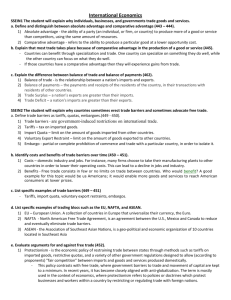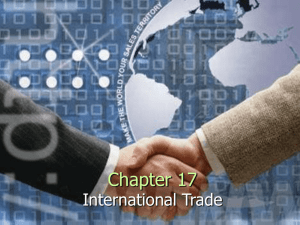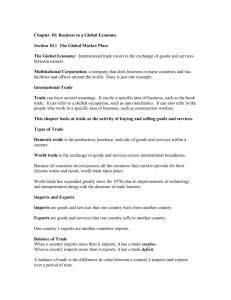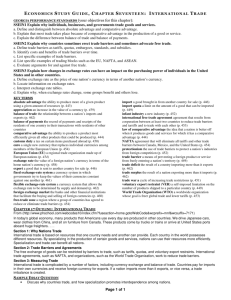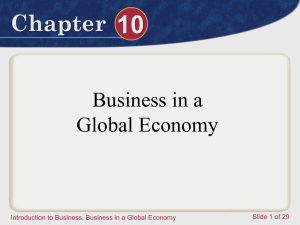Global Economics
advertisement
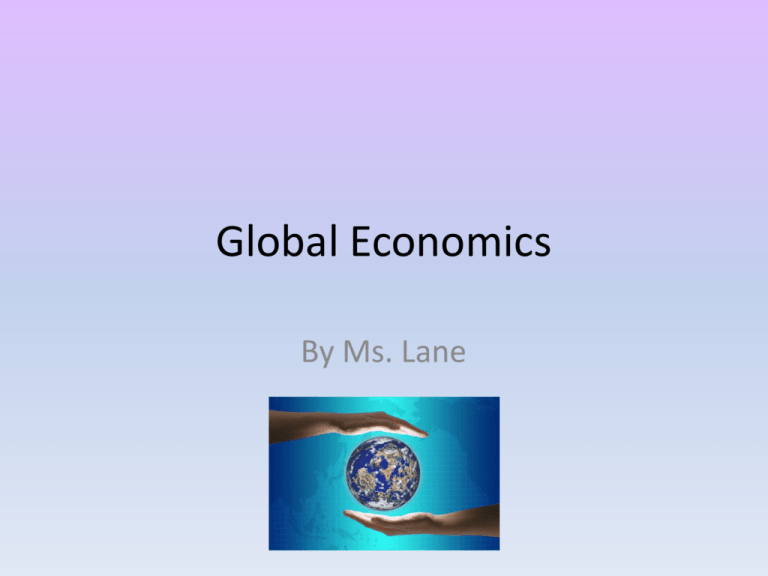
Global Economics By Ms. Lane Why have you traded things you owned? • Think about why you have traded clothes, lunches, toys, jewelry, hats, CDs, baseball cards, etc. with friends and/or relatives over the years. • Why have you made trades? I can describe the effects of international trade on people and nations. Why do nations trade with each other? • Nations trade because: – One nation cannot produce everything that the people want – Trading makes the standard of living better for the people – Trading helps nations specialize and use resources efficiently • This is an economic issue as it relates to resource availability – Each country has different amounts of resources available – Resources are called factors of production – The factors of production that are most important for analyzing global economics are: • • • • Land (natural resources) Labor Human capital Physical capital • Compare the USA and your two assigned countries to determine: – What they should specialize in based on their factors of production – How they may use resources efficiently I can describe the effects of international trade on people and nations. Using resources efficiently • Use the CIA World Factbook to collect data about the two countries that have been assigned to you. • Read pages 441-443 to help you compare and rank the countries. • What should each country specialize in? • Specialization-the concentration of productive efforts of individuals and firms on a limited number of activities – Making a few goods well (specializing) is important because: • Resources are used efficiently • Trading goods help countries get goods they want I can compare the similarities and differences between economic systems. Countries have advantages • Absolute advantage-the ability to produce more of a given product using a given amount of resources – Examples of Absolute Advantage • USA: corn, wheat • Costa Rica: coffee • Venezuela: oil • Give an example of an absolute advantage you have over others. • Why does absolute advantage exist? Comparative Advantage • A comparative advantage is the ability to produce a product most efficiently given all the other products that could be produced. • Give an example of a comparative advantage you have over a friend or relative. – Example of Comparative Advantage For every computer China produces, they cannot make 5 smart phones. Sweden cannot make 3 smart phones for every computer they manufacture. Which country should produce computers rather than smart phones? Why? I can illustrate comparative advantage and its affect on trade. Comparative Advantage Practice • For every microwave oven Korea produces, they cannot make 4 coffee makers. Japan cannot make 2 coffee makers for every microwave oven they manufacture. Which country should produce microwave ovens rather than coffee makers? Why? • What should each country specialize in? I can illustrate comparative advantage and its affect on trade. or ? Comparative Advantage: Korea versus Japan Available Resource Usage Producing Microwave Ovens or Coffee Makers Country Name Global Trade Issues: Why are so many goods made in China? • Watch the video: The dark side of shiny Apple products • http://www.cbsnews.com/8301-3445_16257367950/the-dark-side-of-shiny-apple-products/ • Analyze the positive & negative effects of trade with China • Why are so many goods made in China? • What can we do to make the situation better? I can evaluate the costs and benefits of the different economic systems. Global Trade Issues: Destruction of the Environment • http://www.youtube.com/watch?v=hzz6TWN RUAc • http://www.rainforestinfo.org.au/background /causes.htm • What are the costs of making goods overseas? • What are the benefits of making goods overseas? • How do property rights effect the destruction of the environment? I can evaluate the costs and benefits of the different economic systems. I can relate economic connections and differing costs of production to trading patterns. Global Trade Issues: Copyrights & Patents • Watch & Analyze: – Protected Content: Copyright and fair use video The US government has provided protection for inventors by granting: Copyrights-protection from the US government that grants a creative person the exclusive right to publish and sell creative works. Trademarks-a distinctive symbol, word, name or device that only the owner may use Patents-protection for an inventor that allows this person to gain all income from the invention for 20 years. – What are the differences between these protections? – Why does the US government provide these protections to inventors? – Copyright counterfeiters video • How did the business in the video break the law? • Which protection was violated? • How does this violation hurt New Balance? I can describe how private property rights conserve scarce resources and provide incentives. Section Review • Go to Quizlet: http://quizlet.com/_cu1wu – Complete Learn, Scatter, Test until you have earned an “A” • Go to Studyisland.com and take the quiz: Global Economics • Complete AFL numbers: 1b, 2b,3b, 4b, 6b International Trade Trading with the world • There are two key trading terms: – Imports • A good that is brought in from another country for sale • Why? – Exports • A good that is sent to another country for sale • Why? • Analyze International Trade – Use the CIA World Factbook to collect data about international trade and the two countries that were assigned to you. Use the information to analyze global trade patterns. I can explain how the concepts of balance of trade and balance of payments are used to measure international trade. Analyzing Trade • Free trade means governments do not make laws to control trading between nations • Many countries make laws to control trade. Why? • To protect _____ and __________ in their own country I can analyze the effects of free trade, trade agreements and protectionism. Trade control vocabulary Trade barrier-a means of preventing a foreign product or service from freely entering a nation’s territory – Import quota-limit on amount of a good that can be imported • • • • • Sugar Tobacco Peanuts and peanut butter Many specific dairy products (e.g. powdered milk, baby formula) Beef – Voluntary export restraint • A self-imposed limitation on the number of products shipped to a particular country – Tariff • A tax on imported goods I can analyze the effects of free trade, trade agreements and protectionism. Protecting Business • Scenario: Make a list of car manufacturers. • How many of the manufacturers are American? • Why would the US want to impose a tariff on foreign cars – 3 reasons a tariff may help the economy – How could the tariff backfire and hurt the economy? I can analyze the effects of free trade, trade agreements and protectionism. Measuring Trade • Trade between countries is complicated because each country has a different currency or type of money • Exchange Rate-the value of a foreign country’s currency in terms of the home country’s currency • Exchange rate table to the right show the amount of foreign currency one can exchange a US dollar for on March 30, 2013. The rate changes every day. • If the US dollar declines in value against the British Pound and Indian Rupee, the US dollar will buy fewer of each currency. • An increase in the value of a currency is called appreciation. • A decrease in the value of a currency is called depreciation. I can predict how exchange rates affect international trade. Calculating Rate of Exchange • Scenario 1: Your family will vacation in Mexico this summer. How much will the hotel room cost? – Hotel room = 500 pesos – 10 pesos = $1 (Exchange rate) – 500 pesos/10 pesos per dollar = $50.00 • Scenario 2: Your family waits until September to go to Mexico. – The exchange rate has changed. It is now: 11 pesos = $1 (Exchange rate) What has happened to price of the hotel room? I can predict how exchange rates affect international trade. Exchange Rate Problem • You are travelling to Brazil for a vacation. You decide to buy a Brazilian soccer uniform as a gift for your cousin. • The Brazilian currency is called Real. • The jersey costs 1500 Reals. • The exchange rate between American dollars and Brazilian Reals is $1 (US) for R$30. • How many dollars will the jersey cost? I can predict how exchange rates affect international trade. The Balance of Trade • Countries want to balance the amount of imports (goods brought in from another country for sale) with the amount of exports (goods sent to other countries for sale). • If Imports > exports = currency value decreases • Lower currency value leads to higher prices for imports…consumers then pay more for goods I can explain how the concepts of balance of trade and balance of payments are used to measure international trade. More Trade Vocabulary • Trade surplus = Exports > Imports (for a country) • Trade deficit = Imports > Exports (for a country) • Balance of trade = relationship between a nation’s imports and exports Import Export Comparing Trade by Country • Complete the table for the countries you studied • Which countries have a trade surplus? • Which countries have a trade deficit? • How can the trade situation help or hurt the currency (money) of each country? Unit review • Go to Quizlet: http://quizlet.com/_cveaz – Complete Learn, Scatter, Test until you have earned an “A” • Go to Studyisland.com and take the quiz: International Trade • Complete AFL numbers: 5b, 7b,8b, 9b

